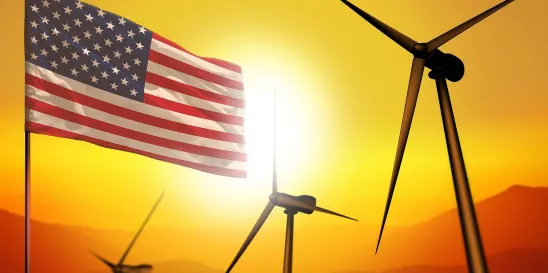The offshore wind industry now has California’s answer to a pressing concern—how might the state procure this generation resource? California Governor Gavin Newsom recently signed a suite of bills that create a mechanism for the state to procure offshore wind energy.
The bulk of these policy reforms are found in Assembly Bill No. 1373 (AB 1373), which authorizes central procurement of “clean energy sources.” Further reforms are found in Senate Bill No. 286 (SB 286) and Assembly Bill No. 3 (AB 3)—laws designed to streamline the path for offshore wind development.
AB 1373 – Central Procurement and Better Planning for Resource Adequacy
AB 1373 sets the stage for a comprehensive expansion of California’s offshore wind development efforts. The new law, signed by Gov. Newsom on October 7, 2023, permits the state to sign long-term contracts for the purchase of electricity from offshore wind facilities. The law also seeks to bolster California’s system resource adequacy by introducing a series of reporting obligations and penalties for noncompliance with mandatory planning reserve margins.
Central Procurement
Certain generation resources require long development and permitting timelines and may be of such a scale that individual load-serving entities in California may not be able to secure these resources efficiently. AB 1373 now provides a mechanism that allows the California Department of Water Resources (CDWR) to centrally procure these resources upon specific findings by the California Public Utilities Commission (CPUC) that these eligible energy resources (like offshore wind) should be procured to meet the state’s growing need for cost-effective resource diversity. CDWR would not be limited to a single solicitation but could conduct “one or more” competitive solicitations. While the specific details of the solicitation process remain to be developed, AB 1373 requires CDWR to consider certain factors when evaluating bids, including the project’s viability and ability to meet in-service dates, the useful life of the project, the project’s ability to supply energy and ancillary services at different times and locations, community impact and workforce development needs, and the developer’s plan for monitoring coastal waters and wildlife.
Further, following a finding by the CPUC that the contract (1) is just and reasonable and in the public interest and (2) will not unreasonably increase costs to customers on a net present value basis, CDWR is now empowered to allocate fractional costs of this energy to California’s dozens of load-serving entities. To be clear, procurement of energy from large-scale, long-lead generation resources is not required by AB 1373, but the legislation creates a helpful path for the route to market and re-affirms California’s determination to develop floating offshore wind energy.
CDWR’s central procurement authority has a finite lifespan and is scheduled to end by 2035.
A Revised Approach to Resource Adequacy
AB 1373 also alters California’s resource adequacy planning standards. Relevant to procurement, the law authorizes a local publicly owned electric utility to meet its minimum planning reserve margin through individual contractual procurement, or through an aggregated or pooled portfolio of resources. Beginning on or before June 30, 2027, the CPUC will annually assess a capacity payment on each load-serving entity that failed to meet its system resource adequacy requirements. Additionally, the California Energy Commission (CEC) will be required to produce a report that includes an assessment of whether each local publicly owned electric utility exceeded, met, or failed to meet its minimum planning reserve margin and specific system adequacy requirements.
Prior to passage of AB 1373, California law prohibited an electrical corporation from beginning the construction of a transmission line without having first obtained from the CPUC a certificate that the public convenience and necessity require that construction. But under the new law, the CPUC is required to establish a rebuttable presumption regarding need for the proposed transmission project in favor of a CAISO-governing-board-approved need evaluation, if specific requirements are satisfied. These changes are expected to incentivize the development of transmission projects that can facilitate prospective growth in offshore wind generation.
Additional Reforms in AB 3 and SB 286
Together, AB 3 and SB 286 introduce numerous changes to streamline the offshore wind permitting process, evaluate gaps in supply chain and workforce readiness, and establish a framework for compensation to certain stakeholders impacted by offshore wind development, as summarized below.
- AB 3 (California Offshore Wind Advancement Act): AB 3 requires state officials to prepare a “second-phase” plan for seaport readiness that builds upon the recommendations in the state’s anticipated strategic plan for offshore wind energy development (required by Assembly Bill No. 525). The bill also requires the CEC to assess the state’s current capabilities to manufacture offshore wind components and identify workforce and supply chain improvements, to enable a majority of the components to be manufactured in-state. Various reports to the Governor and Legislature would be due on or before December 31, 2026.
- SB 286: SB 286 revises processes to clarify the roles and obligations of state entities involved in the permitting or environmental review of offshore wind projects. Specifically, the law requires the California Coastal Commission to process a consolidated coastal development permit for any new development that requires said permit and is “associated with, appurtenant to, or necessary for” the construction and operation of offshore wind energy projects and transmission facilities needed for those projects. SB 286 also designates the State Lands Commission (SLC) as the lead agency for California Environmental Quality Act purposes and directs the SLC to prepare all environmental documents required by law. Finally, SB 286 establishes the California Offshore Wind Energy Fisheries Working Group and tasks the group with developing statewide strategies for mitigating impacts to fisheries, as well as a framework for reasonable compensatory mitigation for unavoidable impacts associated with offshore wind energy projects.
Together, and building upon the studies and analyses required by AB 525, these new laws comprise California’s most recent efforts to become a leader in floating offshore wind energy.




 />i
/>i

